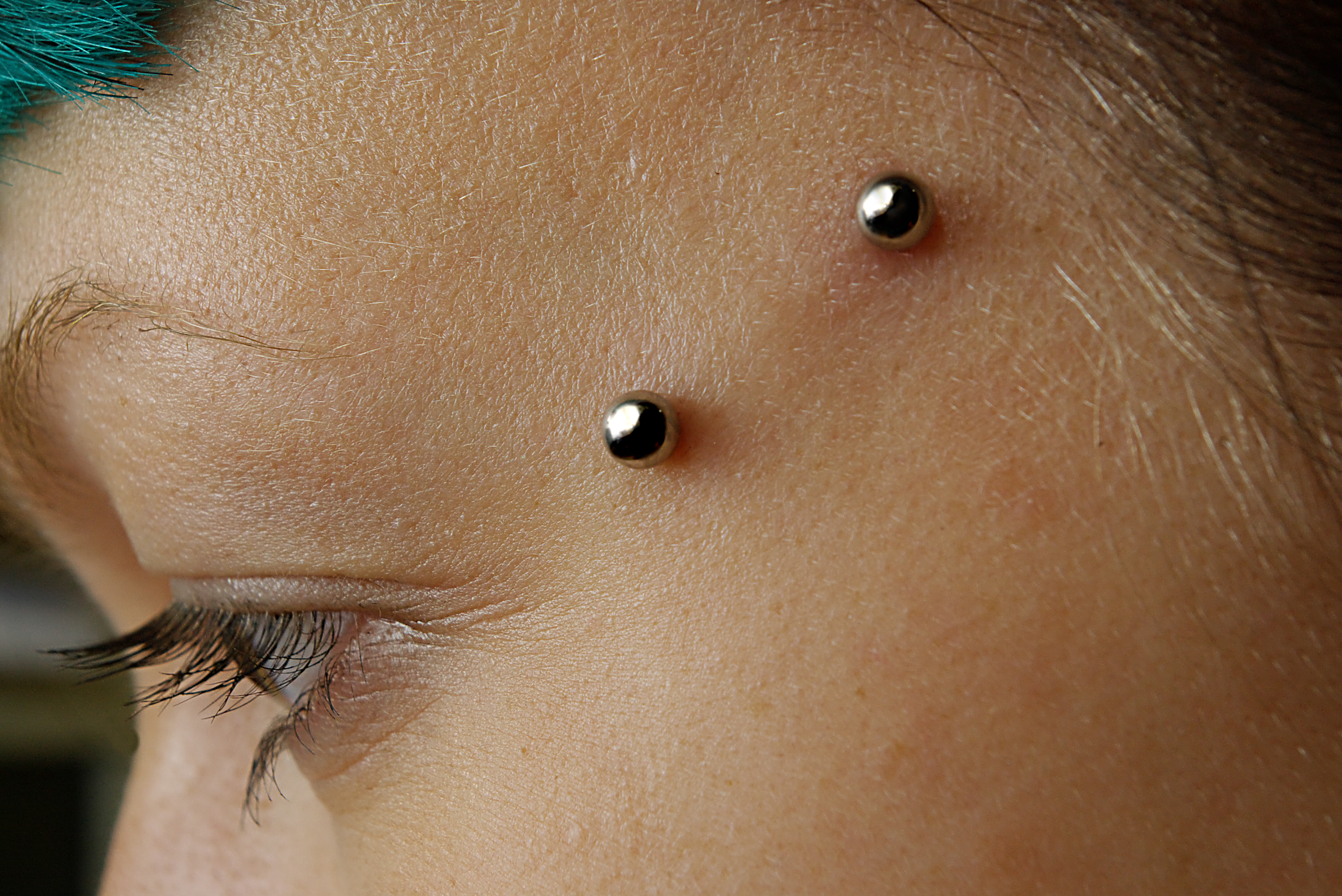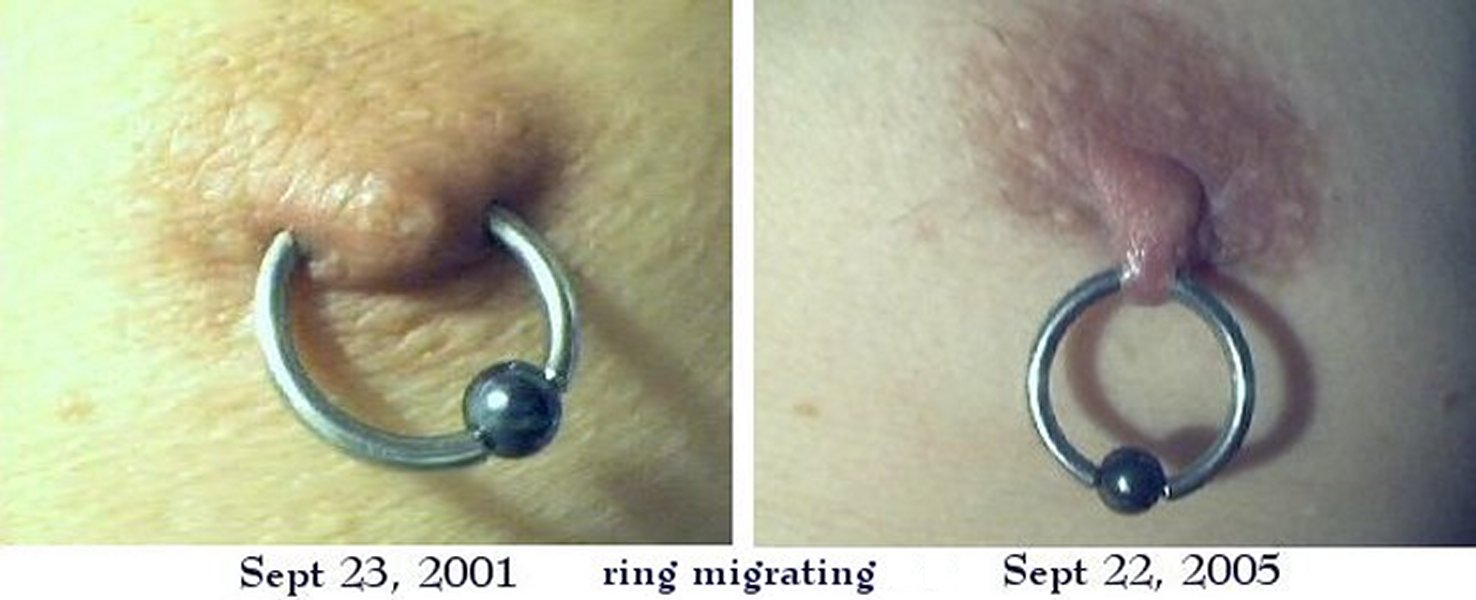|
Nape Piercing
A nape piercing is a piercing through the surface of the nape (back part) of the neck. Nape piercings are a type of surface piercing. They carry a high rate of rejection and migration, ''A Statistical Look at Surface Bars'' unless they are properly measured and placed. They may reject if they are not pierced properly, as they are in a part of the body that moves constantly and are easy to irritate, catching on clothing or other objects. Being surface piercings, nape piercings require special jewelry to minimize the risk of and rejection. Both surface bars and |
Nape
The nape is the back of the neck. In technical anatomical/medical terminology, the nape is also called the nucha (from the Medieval Latin rendering of the Arabic , "spinal marrow"). The corresponding adjective is ''nuchal'', as in the term ''nuchal rigidity'' for neck stiffness. In many mammals the nape bears a loose, non-sensitive area of skin, known as the scruff, by which a mother carries her young by her teeth, temporarily immobilizing it during transport. In the mating of cats the male will grip the female's scruff with his teeth to help immobilize her during the act, a form of pinch-induced behavioral inhibition Pinch-induced behavioural inhibition (PIBI), also called dorsal immobility, transport immobility or clipnosis, is a partially inert state which results from a gentle squeeze of the skin behind the neck. It is mostly observed among cats and allows .... Cultural connotations In traditional Japanese culture, the was one of the few areas of the body (other than ... [...More Info...] [...Related Items...] OR: [Wikipedia] [Google] [Baidu] |
Neck
The neck is the part of the body on many vertebrates that connects the head with the torso. The neck supports the weight of the head and protects the nerves that carry sensory and motor information from the brain down to the rest of the body. In addition, the neck is highly flexible and allows the head to turn and flex in all directions. The structures of the human neck are anatomically grouped into four compartments; vertebral, visceral and two vascular compartments. Within these compartments, the neck houses the cervical vertebrae and cervical part of the spinal cord, upper parts of the respiratory and digestive tracts, endocrine glands, nerves, arteries and veins. Muscles of the neck are described separately from the compartments. They bound the neck triangles. In anatomy, the neck is also called by its Latin names, or , although when used alone, in context, the word ''cervix'' more often refers to the uterine cervix, the neck of the uterus. Thus the adjective ''cervical'' ma ... [...More Info...] [...Related Items...] OR: [Wikipedia] [Google] [Baidu] |
Barbell (piercing)
Barbell style piercing jewelry is composed of a straight bar with a bead on each end, one or both beads unscrewable for removal and/or changing of the beads. Often one of the beads is fixed, either via epoxy or welding, so that only one bead is used to install or remove the jewelry. Barbell threads are usually right-handed. They are named because they resemble the barbells that are used in weightlifting. Types of barbells Internally threaded barbells Named because the bar has smooth ends with receiving threads tapped into the end of the bar. In internally threaded jewelry, the bead has a receiving tube machined into it (this is referred to as "countersunk"), with a threaded post extending from the center, which mates with the threaded receiving tube on the bar. Being much less likely to cause damage and irritation, especially at the time of piercing, internally threaded jewelry is considered superior to externally threaded jewelry. It is usually slightly more expe ... [...More Info...] [...Related Items...] OR: [Wikipedia] [Google] [Baidu] |
Surface Bar
Barbell style piercing jewelry is composed of a straight bar with a bead on each end, one or both beads unscrewable for removal and/or changing of the beads. Often one of the beads is fixed, either via epoxy or welding, so that only one bead is used to install or remove the jewelry. Barbell threads are usually right-handed. They are named because they resemble the barbells that are used in weightlifting. Types of barbells Internally threaded barbells Named because the bar has smooth ends with receiving threads tapped into the end of the bar. In internally threaded jewelry, the bead has a receiving tube machined into it (this is referred to as "countersunk"), with a threaded post extending from the center, which mates with the threaded receiving tube on the bar. Being much less likely to cause damage and irritation, especially at the time of piercing, internally threaded jewelry is considered superior to externally threaded jewelry. It is usually slightly more expen ... [...More Info...] [...Related Items...] OR: [Wikipedia] [Google] [Baidu] |
Nape Piercing Neck
The nape is the back of the neck. In technical anatomical/medical terminology, the nape is also called the nucha (from the Medieval Latin rendering of the Arabic , "spinal marrow"). The corresponding adjective is ''nuchal'', as in the term ''nuchal rigidity'' for neck stiffness. In many mammals the nape bears a loose, non-sensitive area of skin, known as the scruff, by which a mother carries her young by her teeth, temporarily immobilizing it during transport. In the mating of cats the male will grip the female's scruff with his teeth to help immobilize her during the act, a form of pinch-induced behavioral inhibition Pinch-induced behavioural inhibition (PIBI), also called dorsal immobility, transport immobility or clipnosis, is a partially inert state which results from a gentle squeeze of the skin behind the neck. It is mostly observed among cats and allows .... Cultural connotations In traditional Japanese culture, the was one of the few areas of the body (other than ... [...More Info...] [...Related Items...] OR: [Wikipedia] [Google] [Baidu] |
Body Piercing
Body piercing, which is a form of body modification, is the practice of puncturing or cutting a part of the human body, creating an opening in which jewelry may be worn, or where an implant could be inserted. The word ''piercing'' can refer to the act or practice of body piercing, or to an opening in the body created by this act or practice. It can also, by metonymy, refer to the resulting decoration, or to the decorative jewelry used. Piercing implants alter body and/or skin profile and appearance (e.g. golden threads installed subdermal, platinum, titanium or medical grade steel subdermal implants). Although the history of body piercing is obscured by popular misinformation and by a lack of scholarly reference, ample evidence exists to document that it has been practiced in various forms by multiple sexes since ancient times throughout the world.Body piercing can be performed on people of all ages, although most minors are only permitted to have earlobe piercings. Ear piercin ... [...More Info...] [...Related Items...] OR: [Wikipedia] [Google] [Baidu] |
Nape
The nape is the back of the neck. In technical anatomical/medical terminology, the nape is also called the nucha (from the Medieval Latin rendering of the Arabic , "spinal marrow"). The corresponding adjective is ''nuchal'', as in the term ''nuchal rigidity'' for neck stiffness. In many mammals the nape bears a loose, non-sensitive area of skin, known as the scruff, by which a mother carries her young by her teeth, temporarily immobilizing it during transport. In the mating of cats the male will grip the female's scruff with his teeth to help immobilize her during the act, a form of pinch-induced behavioral inhibition Pinch-induced behavioural inhibition (PIBI), also called dorsal immobility, transport immobility or clipnosis, is a partially inert state which results from a gentle squeeze of the skin behind the neck. It is mostly observed among cats and allows .... Cultural connotations In traditional Japanese culture, the was one of the few areas of the body (other than ... [...More Info...] [...Related Items...] OR: [Wikipedia] [Google] [Baidu] |
Surface Piercing
Surface piercings are piercings that are found on flat parts of the body, giving a double-pierced look that sits flat against the skin. A surface bar follows the plane of skin, while a standard piercing is pierced through the plane. Standard piercings have an entrance hole with an exit hole that is usually directly behind the entrance hole, whereas with a surface piercing the entrance and exit holes are next to each other on the skin surface. Types Some examples of surface piercings: *Corset piercing: a series of bilaterally symmetrical piercings, normally done on the back, intended to be laced like a corset. *Christina piercing: located at the mons pubis. *Madison piercing: a horizontal piercing located just above the collarbone, at the base of the neck. *Nape piercing: located on the back of the neck. *Neck piercing: located on the side of the neck. It is also called "Vampire Bites". *Hip piercing: located on or beside the hips (on the pelvis near the hips bones). *Wrist piercin ... [...More Info...] [...Related Items...] OR: [Wikipedia] [Google] [Baidu] |
Piercing Migration
Piercing migration is the process that occurs when a body piercing moves from its initial location. This process can be painful or go unnoticed, until it has progressed. Given enough time, a ring may migrate entirely outside of the skin, although it may only migrate a small amount and come to rest. Potential causes and effects of migration The effects of migration can vary widely. The most common form of migration is the way that heavy small gauge earrings will migrate downwards out of the earlobe, as is common in older women who have worn earrings most of their lives. This is known as the "cheesecutter effect", as its action is easily compared to the method of cutting cheese with a fine wire. Contemporary body and ear piercing jewelry is much more balanced in its weight to gauge ratio, although migration is still possible with heavy jewelry, even if it is of large gauge. Play or movement of the area pierced or implanted can also lead to migration, but it's not likely. Sometimes ... [...More Info...] [...Related Items...] OR: [Wikipedia] [Google] [Baidu] |
Teflon
Polytetrafluoroethylene (PTFE) is a synthetic fluoropolymer of tetrafluoroethylene that has numerous applications. It is one of the best-known and widely applied PFAS. The commonly known brand name of PTFE-based composition is Teflon by Chemours, a spin-off from DuPont, which originally discovered the compound in 1938. Polytetrafluoroethylene is a fluorocarbon solid, as it is a high-molecular-weight polymer consisting wholly of carbon and fluorine. PTFE is hydrophobic: neither water nor water-containing substances wet PTFE, as fluorocarbons exhibit only small London dispersion forces due to the low electric polarizability of fluorine. PTFE has one of the lowest coefficients of friction of any solid. Polytetrafluoroethylene is used as a non-stick coating for pans and other cookware. It is non-reactive, partly because of the strength of carbon–fluorine bonds, so it is often used in containers and pipework for reactive and corrosive chemicals. Where used as a lubricant, PT ... [...More Info...] [...Related Items...] OR: [Wikipedia] [Google] [Baidu] |
Titanium
Titanium is a chemical element with the symbol Ti and atomic number 22. Found in nature only as an oxide, it can be reduced to produce a lustrous transition metal with a silver color, low density, and high strength, resistant to corrosion in sea water, aqua regia, and chlorine. Titanium was discovered in Cornwall, Great Britain, by William Gregor in 1791 and was named by Martin Heinrich Klaproth after the Titans of Greek mythology. The element occurs within a number of minerals, principally rutile and ilmenite, which are widely distributed in the Earth's crust and lithosphere; it is found in almost all living things, as well as bodies of water, rocks, and soils. The metal is extracted from its principal mineral ores by the Kroll and Hunter processes. The most common compound, titanium dioxide, is a popular photocatalyst and is used in the manufacture of white pigments. Other compounds include titanium tetrachloride (TiCl4), a component of smoke screens and catalysts; and ... [...More Info...] [...Related Items...] OR: [Wikipedia] [Google] [Baidu] |
Surface Anchor
A surface, as the term is most generally used, is the outermost or uppermost layer of a physical object or space. It is the portion or region of the object that can first be perceived by an observer using the senses of sight and touch, and is the portion with which other materials first interact. The surface of an object is more than "a mere geometric solid", but is "filled with, spread over by, or suffused with perceivable qualities such as color and warmth". The concept of surface has been abstracted and formalized in mathematics, specifically in geometry. Depending on the properties on which the emphasis is given, there are several non equivalent such formalizations, that are all called ''surface'', sometimes with some qualifier, such as algebraic surface, smooth surface or fractal surface. The concept of surface and its mathematical abstraction are both widely used in physics, engineering, computer graphics, and many other disciplines, primarily in representing the surfac ... [...More Info...] [...Related Items...] OR: [Wikipedia] [Google] [Baidu] |




.jpg)





